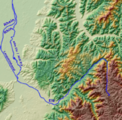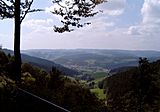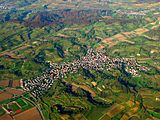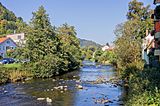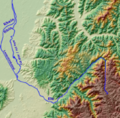Battle of Emmendingen facts for kids
Quick facts for kids Battle of Emmendingen |
|||||||
|---|---|---|---|---|---|---|---|
| Part of the War of the First Coalition | |||||||
 Moreau's troops withdraw through the Val d'Enfer (Valley of Hell) |
|||||||
|
|||||||
| Belligerents | |||||||
| Commanders and leaders | |||||||
| Jean Moreau Michel de Beaupuy † |
Archduke Charles Wilhelm von Wartensleben † |
||||||
| Strength | |||||||
| 32,000 available Unknown number engaged |
28,000 available Approximately 10,000 engaged |
||||||
| Casualties and losses | |||||||
| 1,000 killed and wounded approximately 1,800 captured; 2 artillery pieces |
1,000 killed or wounded | ||||||
The Battle of Emmendingen took place on October 19, 1796. It was a fight between the French Army, led by Jean Victor Marie Moreau, and the First Coalition Army, commanded by Archduke Charles, Duke of Teschen. The battle happened near Emmendingen, a town in southern Germany. This area is about 9 miles (14 km) north of Freiburg im Breisgau.
This battle was part of the War of the First Coalition. This was the first big conflict in the larger French Revolutionary Wars. After a summer of fighting, the French army was retreating through the Black Forest towards the Rhine River. The Austrian forces were chasing them closely.
The French commander, Moreau, had to split his army. He wanted them to cross the Rhine at three different bridges. But by mid-September, the Austrians controlled two of these crossings. The area around Emmendingen was very hilly and rough. This made it easy for the Austrian soldiers to hide and attack the French.
Bad weather also made things difficult for both sides. Rain turned small streams into rushing rivers and made the roads very slippery. The fighting was intense, and two generals, one from each side, died in the battle. The Austrian victory at Emmendingen forced the French to change their retreat plans. They continued their withdrawal through the Black Forest, leading to another battle five days later.
Contents
Understanding the Battle of Emmendingen
Why Did the Battle Happen?
The French Revolution began in 1789, changing France's government. At first, other European rulers saw this as France's internal problem. But as the revolution grew, they became worried about their own power. They also worried about the safety of the French royal family.
In 1792, France declared war on Austria. This started the War of the First Coalition (1792–1798). France fought against many European countries that shared borders with it. By 1793, France faced many problems. Its armies were struggling, and there were revolts within the country. The French army also had many new, untrained soldiers.
Armies and Commanders in 1796
In January 1796, the French and the Coalition agreed to a temporary break in fighting. This truce ended in May 1796. The Coalition armies were made up of soldiers from different states. The main force was the Habsburg (Austrian) army.
The Austrian commander, Archduke Charles, had about 125,000 troops. But these troops were spread out over a very long front. He had to cover a 340 km (211 mi) area from Basel to Frankfurt. The French had two main armies. General Jean-Baptiste Kléber led one, and General Jean Victor Marie Moreau led the other.
The French plan was for two armies to attack the German states. A third army would move towards Vienna through Italy. General Jourdan's army would push southeast. This was meant to distract the Austrians. This would allow Moreau's army to cross the Rhine more easily.
Moreau's army successfully crossed the Rhine. They pushed the Austrians into Bavaria. Jourdan's army also moved eastward. However, the French generals did not join their armies together. This allowed the Austrians, led by Archduke Charles, to unite their forces first. Charles's army defeated Jourdan's army in several battles. This allowed Charles to send more troops south. The next major battle was at Emmendingen.
The Battleground: Emmendingen's Terrain
Emmendingen is in the Elz River valley. This valley winds through the Black Forest. The Elz River creates many "hanging valleys." These are difficult for large groups of soldiers to move through. Heavy rain also made the ground soft and slippery.
The Rhine River and the Elz River had both flooded. Many smaller streams also overflowed. This made it very hard for horses to move, especially during attacks. The area around Riegel am Kaiserstuhl has special soil called loess. This soil forms narrow paths, which made soldiers vulnerable to attacks.
- Terrain in images
-
The loess created alleys through which soldiers had to march, and which made them vulnerable to attacks from above.
Troop Positions Before the Battle
Most of the French army moved through the Höll valley. General Desaix's troops were near Riegel. General Beaupuy's division was between Malterdingen and Emmendingen. Further right, near Emmendingen, was General Saint-Cyr's division. General Ambert's division was in the Elz valley near Waldkirch.
These French positions formed a line about 3 miles (5 km) long. General Ferino's troops were further south and east. Heavy rains had made the ground very difficult for everyone.
The Archduke Charles divided his Austrian forces into four columns. Column Nauendorf moved towards Waldkirch. Wartensleben's column advanced south to capture the Elz bridge at Emmendingen. Latour's column aimed to capture the bridge of Köndringen. Fürstenberg's column held Kinzingen.
The Battle Begins
The French army arrived first at Emmendingen. They secured the high ground at Waldkirch. This gave them control over the nearby valleys. On October 19, the armies faced each other along the Elz River. Moreau realized he couldn't reach Kehl easily. So, he decided to cross the Rhine further north, at Breisach. He sent only his left wing, led by Desaix, to cross there.
At dawn, Saint-Cyr's French troops advanced along the Elz valley. Nauendorf's Austrian forces prepared to move down the valley. Saint-Cyr sent a small group of soldiers to attack Nauendorf's left flank. But Nauendorf had already placed Austrian shooters on the high ground. These shooters ambushed Saint-Cyr's men.
More Austrian gunmen reached Kollnau, which overlooked Waldkirch. From there, they could fire down on the French. The fighting was fierce. The Austrians' better positions forced Saint-Cyr to retreat. He fell back to Waldkirch, and then even further to Denzlingen.
The French left flank also struggled. General Decaen's advance guard moved forward carefully. But Austrian marksmen fired down on them. Decaen was injured when he fell from his horse. General Beaupuy took his place. Later, Beaupuy was killed by a cannonball. His division did not receive the order to retreat, leading to more French losses.
In the center, French riflemen held up two of Wartensleben's Austrian groups. Wartensleben's third group struggled through muddy roads. It took them all day to reach Emmendingen. During the fighting, Wartensleben's left arm was badly injured. Finally, his third column arrived and threatened to surround the French right. The French retreated across the Elz River, destroying the bridges behind them.
By the end of the day, Moreau's French army was in a difficult position. Their forces were spread out over a long, broken line. Despite their success, the Austrians could not completely surround the French. This allowed the French to retreat in good order to the south.
What Happened Next?
Both sides lost a general in the battle. General Michel de Beaupuy of the French army was killed immediately. General Wilhelm von Wartensleben of the Austrian army was shot and died later from his wounds.
Out of about 32,000 French troops, 1,000 were killed or wounded. About 1,800 were captured, and they lost two cannons. The Austrians sent about 10,000 troops into the battle. They lost about 1,000 killed, wounded, or missing.
After Emmendingen, Moreau could not easily get to the Kehl crossing. This forced him to march south. Any retreat into France would have to be through the bridges at Hüningen, which was a longer journey.
The Austrians quickly repaired the bridges and continued chasing Moreau. On October 20, Moreau's army joined with General Ferino's column south of Freiburg. This brought the total French force to about 32,000. Archduke Charles's combined forces, about 24,000 strong, followed Moreau closely. The French army next fought the Archduke at the Battle of Schliengen.
Images for kids
-
The loess created alleys through which soldiers had to march, and which made them vulnerable to attacks from above.


